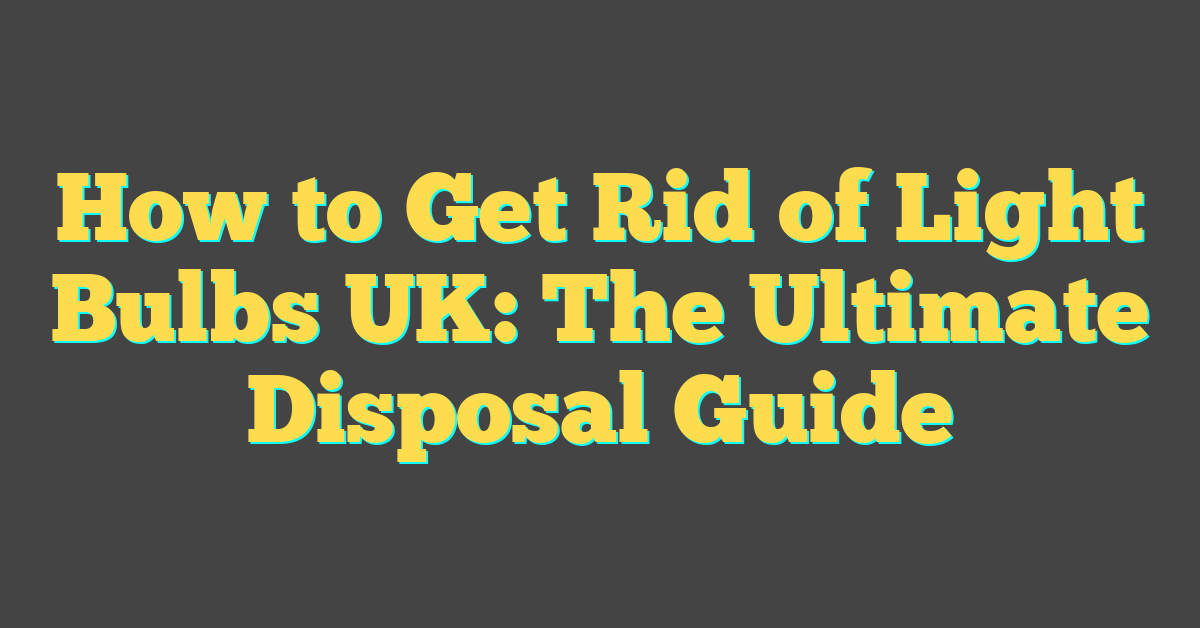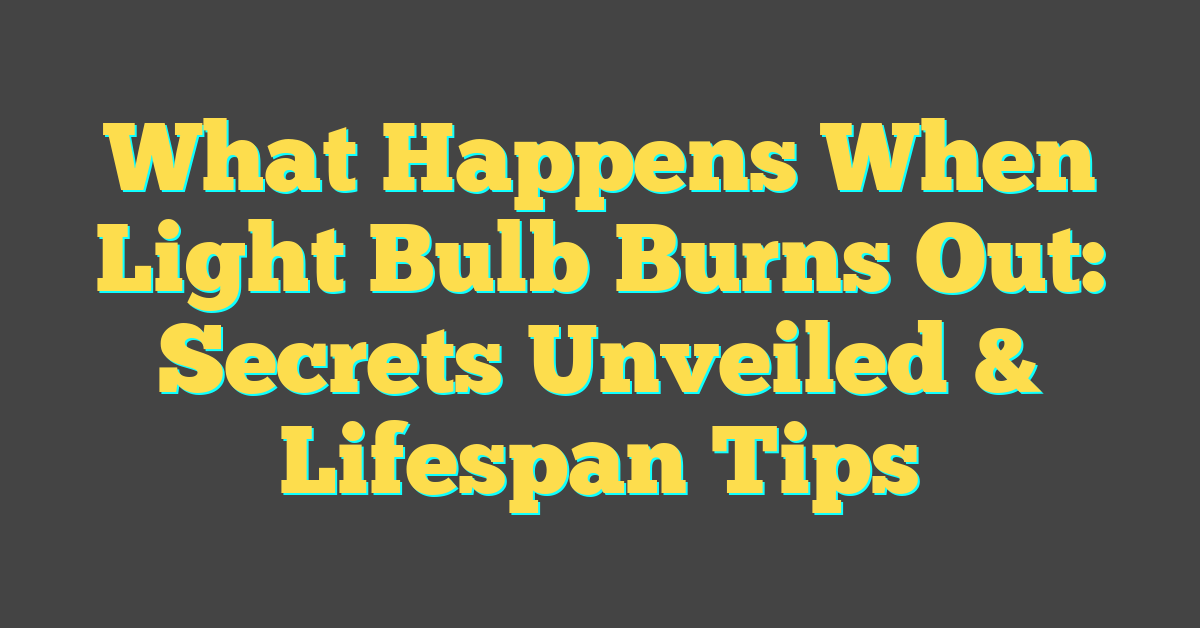Ever found yourself staring at a burnt-out bulb, wondering what’s the eco-friendly way to say goodbye to it? You’re not alone. Disposing of light bulbs isn’t as straightforward as tossing them in the bin, especially in the UK where recycling rules can seem like a puzzle.

But fear not! Whether they’re flickering fluorescents or dimmed-down LEDs, you’ve got options that are both easy and responsible. Let’s shed some light on how to properly dispose of your used bulbs, ensuring you’re not just brightening your home, but also doing your bit for the planet.
Why Properly Disposing of Light Bulbs is Important
You might not think much of it when a light bulb flickers out. You just replace it, right? But what you do with that spent bulb can have a substantial impact on the environment. Proper disposal is key, and here’s why.
When it comes to fluorescent and compact fluorescent lamps (CFLs), there’s a little more at stake. These bulbs contain a small amount of mercury, which, if broken or disposed of in landfills, can release mercury vapor into the environment. This can harm wildlife and contaminate water sources.
Moreover, many bulbs have parts that can be recycled. Glass, metal, and other materials from LED and incandescent bulbs can be given new life in other products. This recycling process conserves resources and energy needed to manufacture new products, cutting down the footprint of your home DIY projects.
Avoiding needless waste also means you support a circular economy – a system that focuses on reusing and recycling materials. Imagine if every home in the UK adopted this approach. You’d be part of a powerful collective effort to reduce waste and protect natural resources.
Beyond the environmental impacts, proper disposal of light bulbs ensures safety too. Broken bulbs pose a risk – from sharp edges that can cause cuts to the potential for hazardous substances causing health issues if not handled correctly. You’re not only protecting the planet but ensuring a safer environment at home and in your community.
Different Types of Light Bulbs and Their Disposal Methods

As a DIY enthusiast, you’re probably aware that different bulbs require different disposal tactics. Let’s shine some light on this. Incandescent bulbs, the old-school kind you grew up with, aren’t recyclable due to their fragile filaments. So when they burn out, you have the green light to toss them in your regular trash. However, wrap them in something to prevent them from breaking and posing a risk to sanitation workers.
On the other hand, halogen bulbs can be treated similarly. While more efficient than incandescents, halogens still aren’t recyclable because of their construction. Again, think safety first and cushion them before discarding.
LED bulbs are a different story. These energy-efficient marvels often contain recyclable materials. Check with your local recycling center to see if they accept LEDs and bask in the glow of doing your part for the planet.
Let’s get serious about fluorescent tubes and CFLs. Due to their mercury content, they should never see the inside of a bin. Instead, take them to your nearest recycling point. Many hardware stores and recycling centers offer services for these bulbs, keeping toxic substances out of the environment.
Here’s a brief rundown to keep you on track:
- Incandescent Bulbs: Dispose of in regular trash, but please wrap them securely.
- Halogen Bulbs: Same as incandescent, with added caution for safety.
- LED Bulbs: Check for local recycling options, as they often contain recyclable components.
- Fluorescent Tubes and CFLs: Use designated recycling services to prevent mercury release.
Remember, you play a pivotal role in conserving resources and ensuring environmental safety with every bulb you dispose of properly. Keep lighting the way towards a more sustainable and responsible future for all those DIY projects to come.
Recycling Options for Light Bulbs in the UK

« Are Light Bulbs Harmful? Uncovering The Shocking Health and Environmental Impact
How to Get Rid of Broken Light Bulbs: A Safe Disposal Guide »
In the UK, your passion for home DIY projects and lighting doesn’t have to end when the light bulb burns out. Recycling options abound, ensuring you can keep making sustainable choices. LED bulbs, for example, are high on the recyclability scale. Many components of these bulbs can be reused or repurposed, reinforcing your eco-friendly efforts.
Local Recycling Centres
Both big and small towns typically have local recycling centres where you can drop off your spent bulbs. Before you head out, make sure to:
- Check online for your nearest recycling centre that accepts light bulbs.
- Confirm their opening hours.
- Understand the type of bulbs they accept, as not all centres process every kind.
The Waste and Resources Action Programme (WRAP) facilitates recycling and waste management. Their website can offer details on nearby facilities and disposal recommendations.
Retailer Take-Back Programs
You might be surprised to learn that some retailers also offer take-back programs. Places where you’ve originally purchased your bulbs might:
- Accept old bulbs for free.
- Provide discounts on new purchases in exchange for old ones.
- Ensure that the materials are handled responsibly.
Council Collections
Many local councils offer specific collection services for light bulbs, especially for the more hazardous fluorescent tubes and CFLs. You can:
- Contact your local council to enquire about collection schedules.
- Arrange a pick-up if you’ve accumulated a significant number of bulbs over time.
- Safely store your bulbs until the collection date to avoid any environmental hazards.
Mail-Back Services
For rarer bulb types or if you’ve got a busy schedule, mail-back services are a convenient option. Some companies provide prepaid mailing containers specifically for bulbs, ensuring they’re sent off to the right facilities without hassle. Just remember to pack them securely to prevent breakage during transport.
By keeping these options in mind, you can continue pursuing your lighting projects with the peace of mind that comes from knowing you’re contributing positively to the environment. Your dedication to proper disposal echoes your passion for lighting up homes, and the planet, in a way that’s both bright and responsible.
How to Safely Handle and Package Light Bulbs for Disposal

Handling light bulbs for disposal requires attention to avoid breakage and potential injury. Since you’re into DIY and lighting projects, you know the value of doing things right. When disposing of LED bulbs, or any light bulbs for that matter, safety is paramount.
First off, always switch off and unplug the lamp or light fixture before replacing the bulb to avoid electrical shock. Ensure the bulb is cool to the touch to prevent burns. Gently unscrew the bulb using a light grip — remember, it’s not a strength test!
In the event you’re dealing with a broken bulb, wear gloves to protect your hands from sharp edges. For intact bulbs, it’s best to wrap them in the original packaging or double-layer them in newspaper or bubble wrap, especially when transporting to a recycling center. This extra padding minimizes the chance of breakage during transit.
Use sturdy boxes or containers for multiple bulbs, separating them with additional cushioning material if possible. Avoid overfilling the box; it’s not a jigsaw puzzle, and you don’t want to force pieces into place. Firmly secure the box with tape and clearly label it as containing light bulbs for recycling. This will alert anyone handling the box to do so with care.
Transporting Bulbs to Recycling Centers
When you’re ready to take your light bulbs to a recycling center, make sure they’re safely stowed in your vehicle. You wouldn’t want them rolling around back there. Lay them flat in your trunk or another stable area, and don’t stack heavy items on top. If you’re using a retailer take-back program, bring bulbs in small groups to prevent accidental breakage from bulk transport.
By following these guidelines, you’ll ensure that your bulbs make it to their recycling destination intact, ready to be broken down responsibly and give their components a second life.
Alternative Methods for Repurposing or Recycling Light Bulbs

Your journey in responsibly getting rid of light bulbs isn’t just about disposal; it’s also about breathing new life into those glass spheres that have brightened your nights and days. Repurposing light bulbs can be a creative and eco-friendly way to reduce waste and add charm to your home.
One of your options is transforming old bulbs into delightful DIY Terrariums. Here’s how you can do it:
- Carefully remove the bulb’s inner workings using needle-nose pliers.
- Fill it with a bit of soil, some moss, and a tiny succulent or air plant.
- Create a small hanging loop with wire or string to display your new mini garden.
Not only does this give a second life to a would-be discarded item, but it also brings a piece of greenery into your space.
If terrariums aren’t your style, consider using bulbs to craft a set of Unique Christmas Ornaments. With a little bit of paint and some crafting finesse, you can turn spent light bulbs into festive holiday decorations. Whether it’s Santa, reindeer, or snowmen, your creativity is the only limit.
Beyond crafting, recycling is another avenue you should explore. The UK has robust programmes for bulb recycling, supporting your environmental efforts.
Here’s a quick look at some resources that can help you recycle:
- Recycling Centres: Drop off light bulbs at local recycling centres equipped to handle them.
- Retailer Take-Back Schemes: Some stores accept old bulbs for recycling when you purchase new ones.
- Specialist Recycling Companies: For bulk quantities, consider contacting a company that specializes in recycling light bulbs.
Remember, compact fluorescent lamps (CFLs) and fluorescent tubes contain small amounts of mercury, so it’s paramount that they go to a facility capable of handling hazardous materials safely – for your well-being and Mother Nature’s.
Conclusion
You’ve now got all the know-how to tackle light bulb disposal with care and responsibility. Remember, taking the time to package your bulbs safely and transport them to the appropriate facilities isn’t just about following regulations—it’s about protecting the environment and contributing to a sustainable future. Whether you’re turning your old bulbs into art or ensuring they’re recycled properly, you’re making a difference. So next time a bulb burns out, you’ll be ready to handle it like a pro. Keep shining bright and doing your part for the planet!
Frequently Asked Questions
How should light bulbs be handled for disposal?
Light bulbs should be handled carefully to avoid breakage. Wear protective gloves, and wrap the bulbs in newspaper or bubble wrap before placing them in a sturdy box.
What is the safest way to package light bulbs for disposal?
The safest way to package light bulbs is to wrap each bulb separately in newspaper or bubble wrap and place them in a box that’s been labeled “fragile” to prevent damage during transport.
Can light bulbs be recycled, and if so, how?
Yes, many light bulbs can be recycled. Transport them to a local recycling center, utilize retailer take-back programs, or find specialty recycling companies that accept light bulbs.
Are there any creative alternatives to disposing of light bulbs?
Yes, light bulbs can be repurposed into DIY projects like terrariums or unique Christmas ornaments. This can be a creative alternative to disposal.
Why is it important to dispose of CFLs and fluorescent tubes properly?
CFLs and fluorescent tubes contain small amounts of mercury, which can be harmful to the environment and human health if not disposed of properly. It is crucial to follow safe disposal guidelines for these items.




